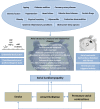Frequent premature atrial contractions as a signalling marker of atrial cardiomyopathy, incident atrial fibrillation, and stroke
- PMID: 35388889
- PMCID: PMC10064848
- DOI: 10.1093/cvr/cvac054
Frequent premature atrial contractions as a signalling marker of atrial cardiomyopathy, incident atrial fibrillation, and stroke
Abstract
Premature atrial contractions are a common cardiac phenomenon. Although previously considered a benign electrocardiographic finding, they have now been associated with a higher risk of incident atrial fibrillation (AF) and other adverse outcomes such as stroke and all-cause mortality. Since premature atrial contractions can be associated with these adverse clinical outcomes independently of AF occurrence, different explanations have being proposed. The concept of atrial cardiomyopathy, where AF would be an epiphenomenon outside the causal pathway between premature atrial contractions and stroke has received traction recently. This concept suggests that structural, functional, and biochemical changes in the atria lead to arrhythmia occurrence and thromboembolic events. Some consensus about diagnosis and treatment of this condition have been published, but this is based on scarce evidence, highlighting the need for a clear definition of excessive premature atrial contractions and for prospective studies regarding antiarrhythmic therapies, anticoagulation or molecular targets in this group of patients.
Keywords: Anticoagulation; Atrial cardiomyopathy; Atrial myopathy; Premature atrial contractions; Stroke; Supraventricular ectopic beats.
© The Author(s) 2022. Published by Oxford University Press on behalf of the European Society of Cardiology.
Conflict of interest statement
Conflict of interest: J.M.F.: none declared; D.G.: institutional research grants from Boston Scientific, Medtronic and Biosense Webster, and personal advisory fees from Boehringer Ingelheim, Boston Scientific and Abbott; G.Y.H.L.: consultant and speaker for BMS/Pfizer, Boehringer Ingelheim and Daiichi-Sankyo. No fees are received personally.
Figures


Similar articles
-
Frequent Premature Atrial Contractions in Cryptogenic Stroke Predict Atrial Fibrillation Detection with Insertable Cardiac Monitoring.Cerebrovasc Dis. 2020;49(2):144-150. doi: 10.1159/000505958. Epub 2020 Feb 5. Cerebrovasc Dis. 2020. PMID: 32023609
-
Excessive Atrial Ectopy and Short Atrial Runs Increase the Risk of Stroke Beyond Incident Atrial Fibrillation.J Am Coll Cardiol. 2015 Jul 21;66(3):232-241. doi: 10.1016/j.jacc.2015.05.018. J Am Coll Cardiol. 2015. PMID: 26184616
-
Consequences of chronic frequent premature atrial contractions: Association with cardiac arrhythmias and cardiac structural changes.J Cardiovasc Electrophysiol. 2019 Oct;30(10):1952-1959. doi: 10.1111/jce.14067. Epub 2019 Aug 1. J Cardiovasc Electrophysiol. 2019. PMID: 31310360 Free PMC article.
-
Premature atrial contractions: A predictor of atrial fibrillation and a relevant marker of atrial cardiomyopathy.Front Physiol. 2022 Oct 24;13:971691. doi: 10.3389/fphys.2022.971691. eCollection 2022. Front Physiol. 2022. PMID: 36353376 Free PMC article. Review.
-
Frequent premature atrial contractions are associated with atrial fibrillation, brain ischaemia, and mortality: a systematic review and meta-analysis.Europace. 2019 May 1;21(5):698-707. doi: 10.1093/europace/euy276. Europace. 2019. PMID: 30508087
Cited by
-
Prevalence and Associated Factors of Paroxysmal Atrial Fibrillation and Atrial Arrhythmias During Hospitalizations for Exacerbation of COPD.Int J Chron Obstruct Pulmon Dis. 2024 Sep 4;19:1989-2000. doi: 10.2147/COPD.S473289. eCollection 2024. Int J Chron Obstruct Pulmon Dis. 2024. PMID: 39247665 Free PMC article.
-
Atrial Cardiomyopathy in Atrial Fibrillation: A Multimodal Diagnostic Framework.Diagnostics (Basel). 2025 May 10;15(10):1207. doi: 10.3390/diagnostics15101207. Diagnostics (Basel). 2025. PMID: 40428200 Free PMC article. Review.
-
Temporal Patterns of Holter-Detected Arrhythmias in Hypertrophic Cardiomyopathy Patients Treated with Mavacamten.Biomedicines. 2025 Apr 21;13(4):1005. doi: 10.3390/biomedicines13041005. Biomedicines. 2025. PMID: 40299669 Free PMC article.
-
Familial cardiac laminopathy with predominant atrial involvement: a case series of a family with LMNA mutation.Eur Heart J Case Rep. 2025 Mar 15;9(4):ytaf129. doi: 10.1093/ehjcr/ytaf129. eCollection 2025 Apr. Eur Heart J Case Rep. 2025. PMID: 40191628 Free PMC article.
-
Exploring risk Indicators of atrial fibrillation in severe Obesity: Left atrial cardiomyopathy and premature atrial contractions.Int J Cardiol Heart Vasc. 2024 Nov 14;55:101555. doi: 10.1016/j.ijcha.2024.101555. eCollection 2024 Dec. Int J Cardiol Heart Vasc. 2024. PMID: 39624153 Free PMC article.
References
-
- Meng L, Tsiaousis G, He J, Tse G, Antoniadis AP, Korantzopoulos P, Letsas KP, Baranchuk A, Qi W, Zhang Z, Liu E, Xu G, Xia Y, Li G, Roever L, Lip GY, Fragakis N, Liu T. Excessive supraventricular ectopic activity and adverse cardiovascular outcomes: a systematic review and meta-analysis. Curr Atheroscler Rep 2020;22:14. - PubMed
-
- Himmelreich JCL, Lucassen WAM, Heugen M, Bossuyt PMM, Tan HL, Harskamp RE, Van E-JF, Van WH. Frequent premature atrial contractions are associated with atrial fibrillation, brain ischaemia, and mortality: a systematic review and meta-analysis. Europace 2019;21:698–707. - PubMed
-
- Arnar DO, Mairesse GH, Boriani G, Calkins H, Chin A, Coats A, Deharo J-C, Svendsen JH, Heidbüchel H, Isa R, Kalman JM, Lane DA, Louw R, Lip GYH, Maury P, Potpara T, Sacher F, Sanders P, Varma N, Fauchier L, Haugaa K, Schwartz P, Sarkozy A, Sharma S, Kongsgård E, Svensson A, Lenarczyk R, Volterrani M, Turakhia M, Obel IWP, Abello M, Swampillai J, Kalarus Z, Kudaiberdieva G, Traykov VB, Dagres N, Boveda S, Vernooy K, Kalarus Z, Kudaiberdieva G, Mairesse GH, Kutyifa V, Deneke T, Hastrup Svendsen J, Traykov VB, Wilde A, Heinzel FR; ESC Scientific Document Group, EHRA Scientific Documents Committee . Management of asymptomatic arrhythmias: a European Heart Rhythm Association (EHRA) consensus document, endorsed by the Heart Failure Association (HFA), Heart Rhythm Society (HRS), Asia Pacific Heart Rhythm Society (APHRS), Cardiac Arrhythmia Society of Southern Africa (CASSA), and Latin America Heart Rhythm Society (LAHRS). Europace 2019;21:844–845. - PubMed
-
- Goette A, Kalman JM, Aguinaga L, Akar J, Cabrera JA, Chen SA, Chugh SS, Corradi D, D’Avila A, Dobrev D, Fenelon G, Gonzalez M, Hatem SN, Helm R, Hindricks G, Ho SY, Hoit B, Jalife J, Kim Y-H, Lip GYH, Ma C-S, Marcus GM, Murray K, Nogami A, Sanders P, Uribe W, Van WD, Nattel S. EHRA/HRS/APHRS/SOLAECE expert consensus on atrial cardiomyopathies: definition, characterization, and clinical implication. Europace 2016;18:1455–1490. - PMC - PubMed
MeSH terms
LinkOut - more resources
Full Text Sources
Medical

